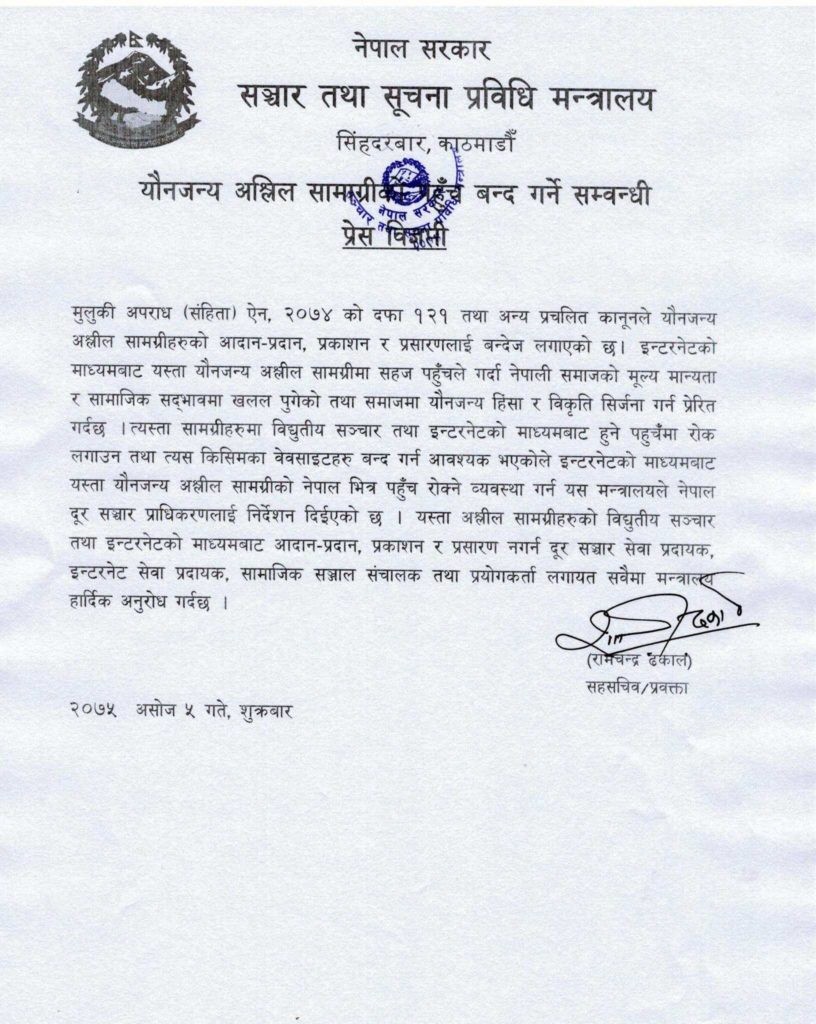The government of Nepal has recently brought into effect the constitution in relation to the distribution of sexual contents in the nation. The Muluki Ain 2074 (Constitution) of Nepal prohibits the broadcasting, distribution, and publication of sexual content. After the Ministry of Communication and Information Technology (MOCIT) instructed the National Telecommunications Authority to ban the access to porn websites, a notice has been issued to all ISPs, telecommunication houses, digital media, and social media operators to ban the display of indecent and obscene sexual content in the country.

The law was brought into effect since Ashwin 5, 2075 (September 21, 2018), after the government stated that the increasing rates of rape crimes in the country are due to the free and easy access to pornography. The lack of action of the government for the prevention of rape cases in the nation has prompted criticism from various activist and rape victim support groups. In an attempt to calm the critics, the law of porn or sexual content prohibition has been focused on by the government of Nepal. But despite the government’s efforts, we need to stop and ask ourselves: Is the ban on sexual content the right solution?

The rape and attempted rape crime rates in Nepal has increased four-folds in the past ten years since 2008. These crime counts include only the reported rates and the unreported rape cases have not been considered in the data. However, it is evident that the rape crimes in Nepal are increasing at an alarming rate, which leaves all the individuals of the country vulnerable to rape crimes.
In the year 2018, very core-shaking rape cases have been brought to the public eye which has enraged the citizens and influenced them to take steps against the growing trend. Even more alarmingly, more than half the victims of rape are minors. All age groups from eight-month olds to 90-year olds and all genders, including males and females, have been exposed to the crime. The young, old and disabled women are more vulnerable to such crimes due to their inability to assess the situation or to defend themselves. On an average, three rapes are reported in Nepal and these are assumed to be only 15% of the total rape cases. The total number of reported rape cases in the fiscal year 2017/18 alone is 1480 and the number of cases that fund justice was less than 20%.

The rules formulated by the government are not strong enough for the rapists and molesters to stop displaying criminal behavior out of fear. The number of cases reported is fairly low due to the victim-blaming culture of Nepal where the victim’s personality, outfit, family is investigated by the society before the rape cases are investigated by the law. On top of that, the statutory limit for reporting a rape case is six months and it is a burden of the victim to provide evidence of the rape through physical signs of molestation and intrusive examinations. All these make it very difficult for the rapists to be convicted and statistics state that while in the district level only 40% rapists are convicted of a crime, in the central level, only 6%. This encourages the rapists by assuring them that they could get away with the crime easily.
The approach of the government towards the ban of sexual content cannot be justified completely. Although there might be chances that the hard porn accessible through most porn sites might have provided the rapists with an idea of how to execute the rape, it is baseless to say that the increase in rape crime rates in the country is due to the availability of porn content. In fact, studies show that in some western countries, the availability of porn could be related to the decrease in crime rates as the built up “desires” of the potential perpetrators are “released” through porn and masturbation before they take any criminal action on others. There are men who watch porn and commit rapes just as there are men who watch porn and don’t commit rapes. In conclusion, the men who commit rapes would have done it regardless of whether or not they watched porn.

The banning of sexual content cannot guarantee that people will not watch porn; it only guarantees that they will not do so openly. People who are interested in porn will find various ways to download such content using a proxy or VPN sites, which allow the users to browse any website by avoiding filters. To top that, there is no guarantee that banning porn will decrease the rates of rapes happening day and night in our country as there is no research that concludes the contribution of sexual digital content in rape cases. Instead, the young users must be educated and warned against the careless consumption of such content.
The right solution that will guarantee the decrease of rape rates in Nepal would be the naming and shaming of rape perpetrators, the hardening of laws such as increased fines and jail time to incite fear among criminals and introduction of physical punishments in extreme cases. The role of police and investigators in preventing and relieving the rape victims is as important as the education of men, women, and children regarding such situations and how to defend oneself. When all these are implemented properly, the will remain no relevance of sexual content in the commitment of rapes as we will see a drastic decrease in the criminal offenses against women and children across the country.
The government will then neither have the reason to nor the need to prohibit such digital content citing the baseless relation between porn and increasing rape crime rates. What are your thoughts on the topic? Comment below.

